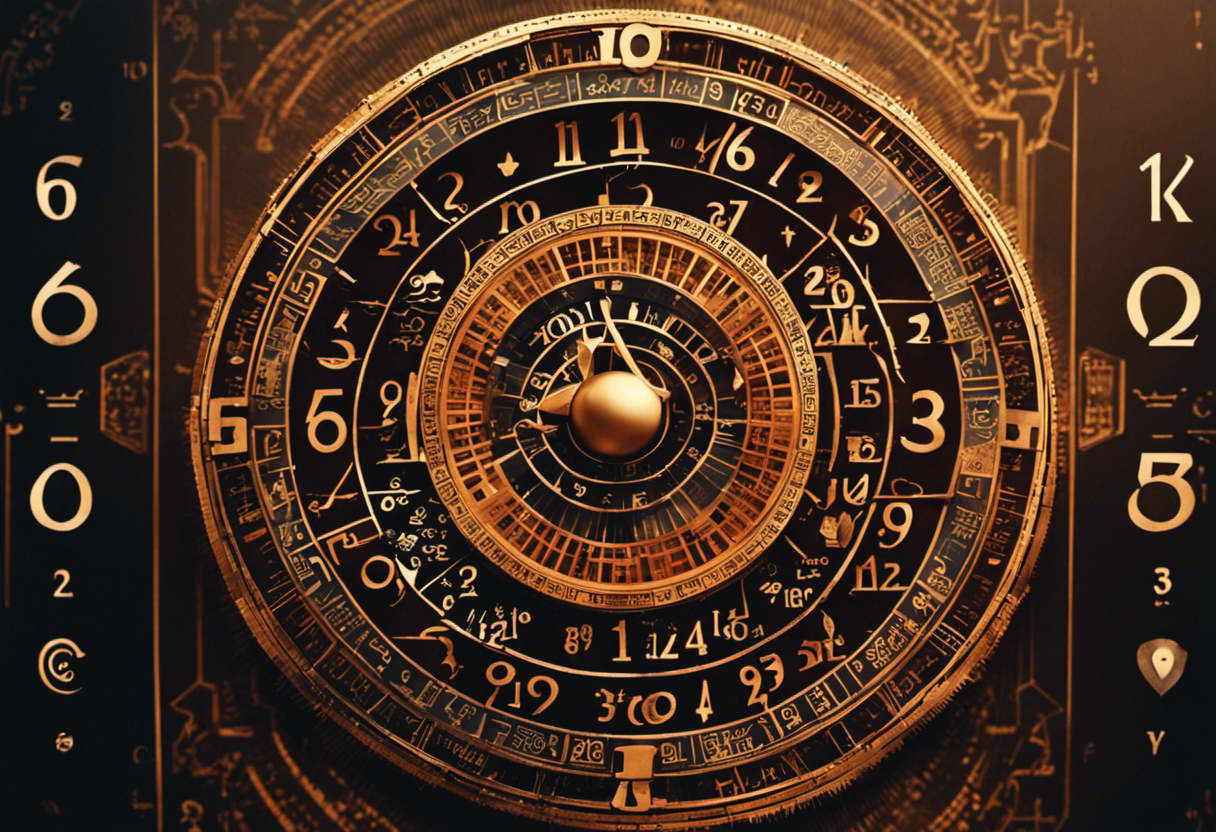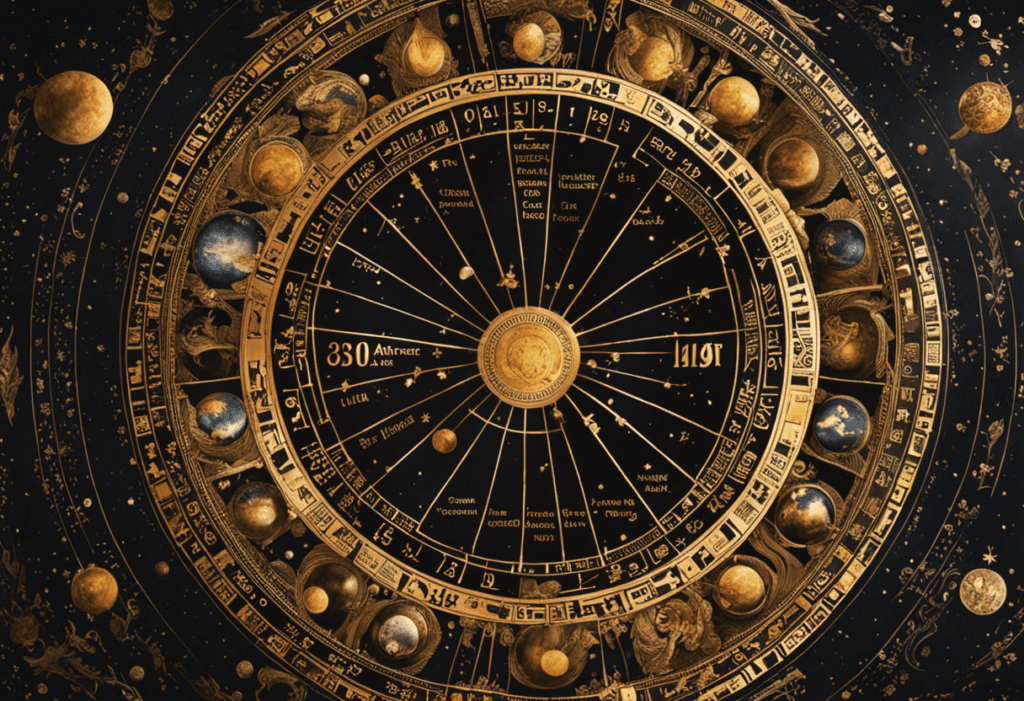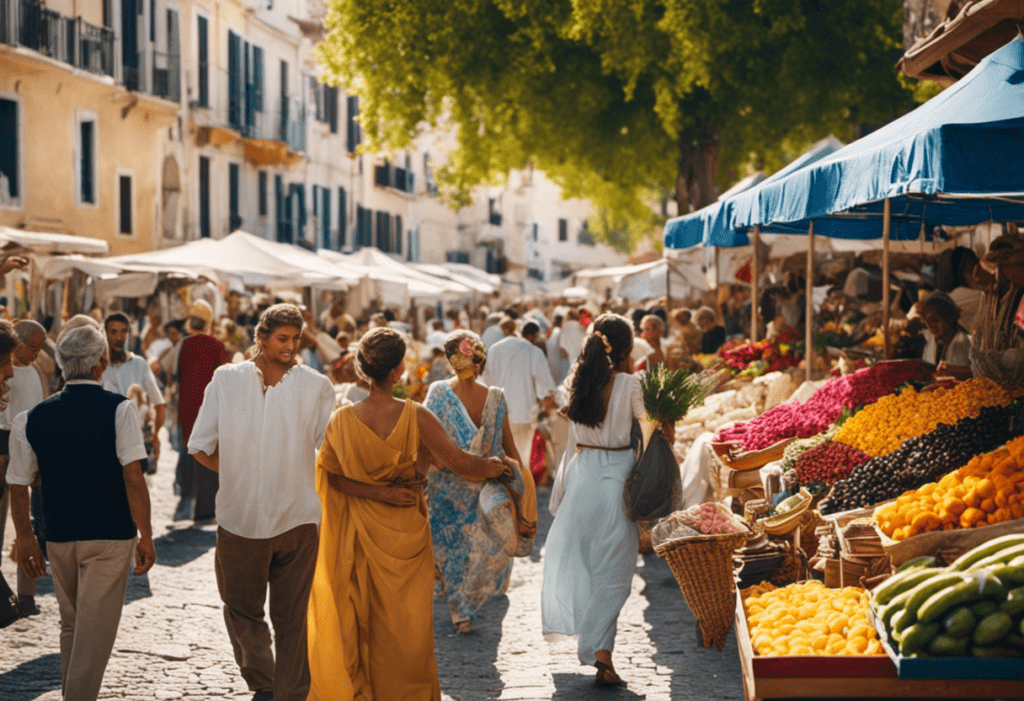Unlocking the ancient secrets of time, the Metonic Cycle illuminates the intricate lunisolar logic that governed the Greek calendar. This article delves into the origins, mathematical brilliance, and cultural significance of the Metonic Cycle in ancient Greece.
By understanding this celestial phenomenon, we gain insight into the religious rituals, agricultural practices, and overarching cultural implications of the Greek civilization.
Furthermore, we explore the enduring legacy of the Metonic Cycle in modern timekeeping. Prepare to embark on a journey of intellectual discovery and unravel the mysteries of time.
Key Takeaways
- The Metonic Cycle was developed by ancient astronomers and mathematicians and named after Meton of Athens.
- It sought to synchronize the solar and lunar calendars by reconciling the 19-year lunar cycle with the 365-day solar year, providing a more accurate and predictable calendar system.
- The Metonic Cycle played a significant role in ancient Greek religion and culture by determining dates for important rituals and observances, integrating lunar phases and solar positions, and influencing festival dates and the timing of religious observances.
- The mathematical calculations behind the Metonic Cycle were crucial for achieving accuracy in the alignment of the solar and lunar calendars.
The Origins of the Metonic Cycle


The development of the Metonic Cycle can be traced back to the ancient astronomers and mathematicians of ancient Greece. These scholars, such as Meton of Athens, observed the complex relationship between the solar and lunar calendars and sought to find a method to synchronize them. The Metonic Cycle, named after Meton, was the result of their efforts.
The origins of the Metonic Cycle lie in the desire to reconcile the 19-year lunar cycle with the 365-day solar year. By observing the movements of the moon and the sun, the ancient Greeks recognized that after 19 solar years, the lunar phases would repeat on the same dates. This discovery had significant historical significance as it allowed for the development of a more accurate and predictable calendar system.
The Metonic Cycle was crucial in various aspects of Greek society and culture. It provided a foundation for the calculation of religious festivals, agricultural cycles, and astronomical predictions. The ability to determine the relationships between the lunar and solar calendars was essential for planning religious ceremonies, agricultural activities, and celestial observations.
The Metonic Cycle’s origins and development paved the way for a more sophisticated understanding of timekeeping and were integral to the development of ancient Greek civilization.
The Lunar and Solar Calendars in Ancient Greece


Studying the interactions between the lunar and solar calendars in ancient Greece provides valuable insights into the timekeeping practices of this civilization. The ancient Greeks recognized the connection between the lunar and solar cycles and sought to harmonize them in their calendar system.
The lunar calendar was based on the cycles of the moon, with each month beginning with the new moon. However, since the lunar year is approximately 354 days long, it fell short of matching the solar year, which is about 365 days long. To reconcile this discrepancy, the ancient Greeks incorporated intercalary months into their lunar calendar. These additional months were inserted periodically to bring the lunar and solar years into alignment.
One of the methods used by the ancient Greeks to achieve lunar-solar harmony was the Metonic cycle, which was named after the Greek astronomer Meton. The Metonic cycle is a 19-year period that includes 235 lunar months and 6,939 days. This cycle was found to be a nearly exact match for 19 solar years, as the difference between the two was only a few hours. By incorporating the Metonic cycle into their calendar system, the ancient Greeks were able to synchronize the lunar and solar calendars for an extended period of time, ensuring that important religious and agricultural events occurred at the appropriate times.
The Mathematical Genius Behind the Metonic Cycle


The Metonic Cycle, a mathematical feat of the ancient Greeks, forms the basis of the lunisolar logic of their calendar. This cycle, which lasts for 19 years, reveals a remarkable correlation between the lunar and solar calendars.
Through the Metonic Cycle, the ancient Greeks were able to synchronize the movements of the sun and moon, allowing them to accurately track time and plan religious and agricultural events.
Metonic Cycle Explained
Mathematical calculations played a crucial role in the development and implementation of the ingenious Metonic Cycle. The accuracy and duration of the Metonic Cycle were determined by these mathematical calculations.
The Metonic Cycle is a period of 19 years, which is almost exactly equal to 235 lunar months. The lunar month is the time it takes for the Moon to complete one cycle of phases, from New Moon to New Moon.
By aligning the solar and lunar calendars, the Metonic Cycle ensured that the phases of the Moon and the seasons of the year remained synchronized. This synchronization was achieved by adding 7 intercalary months to the 19-year cycle, which compensated for the fractional difference between the lunar and solar years.
The mathematical genius behind the Metonic Cycle allowed for an accurate and practical calendar system.
Lunar-Solar Correlation Revealed
Revealing the intricate correlation between the lunar and solar calendars, the Metonic Cycle showcased the remarkable mathematical genius behind its precise calculations.
This correlation was discovered through ancient Greek astronomical observations, where it was observed that the lunar and solar calendars did not align perfectly. While the lunar month consists of approximately 29.5 days, the solar year consists of approximately 365.25 days.
This discrepancy posed a challenge in creating a calendar that accurately accounted for both lunar and solar cycles. However, through careful observation and calculations, the ancient Greeks discovered that after 19 solar years, the lunar and solar calendars aligned almost perfectly.
This discovery led to the formulation of the Metonic Cycle, which provided a mathematical framework for reconciling the lunar and solar calendars and ensuring the accuracy of timekeeping systems.
Ancient Greek Calendar’s Logic
Through meticulous observations and calculations, ancient Greek astronomers ingeniously developed a mathematical framework that harnessed the power of the Metonic Cycle to synchronize the lunar and solar calendars.
The Metonic Cycle’s significance in the ancient Greek calendar was closely tied to religious practices. By accurately tracking the movements of the moon and the sun, the Greeks were able to determine the dates for religious festivals and ceremonies. These events played a central role in their society, and the calendar system ensured that they were celebrated at the appropriate times.
The Metonic Cycle allowed the Greeks to align their religious calendar with the natural cycles of the moon and the sun, ensuring that important rituals and observances occurred at the correct lunar phases and solar positions.
This mathematical genius behind the Metonic Cycle allowed for a harmonious integration of religious and astronomical practices in ancient Greek society.
Significance of the Metonic Cycle in Greek Religion


The Metonic Cycle played a significant role in Greek religion. It had ritual implications and a connection to lunar and solar worship. The precise alignment of the lunar and solar calendars allowed for the coordination of religious festivals and ceremonies with astronomical events. This enhanced the religious experience for worshippers. The Metonic Cycle also influenced the timing and duration of important religious observances. It ensured that they were in harmony with the natural rhythms of the celestial bodies.
Ritual Implications of Metonic
While the Metonic Cycle played a significant role in the ancient Greek calendar, its ritual implications within Greek religion were equally noteworthy. The Metonic Cycle, with its synchronization of the lunar and solar calendars, provided a framework for planning and organizing religious ceremonies and ritual practices.
Here are five key ritual implications of the Metonic Cycle in Greek religion:
- Determining religious festivals: The Metonic Cycle helped in establishing the dates of important religious festivals, such as the Panathenaia and the Dionysia, ensuring they aligned with significant celestial events.
- Harmonizing lunar and solar cycles: The Metonic Cycle allowed for the coordination of lunar and solar cycles, enabling the timing of rituals and ceremonies to align with natural phenomena and celestial events, enhancing their symbolic and spiritual significance.
- Facilitating agricultural rituals: The Metonic Cycle’s ability to harmonize lunar and solar cycles was crucial in determining the optimal timing for agricultural rituals, such as planting and harvesting, which were deeply intertwined with Greek religious practices.
- Ensuring religious purity: The Metonic Cycle enabled the accurate calculation of the dates of religious purification rituals, ensuring adherence to religious laws and maintaining the spiritual integrity of the community.
- Fostering a sense of cosmic order: The Metonic Cycle’s integration of lunar and solar cycles provided a sense of cosmic order and harmony, reinforcing the religious worldview of the ancient Greeks and deepening their connection to the divine.
These ritual implications demonstrate the profound influence of the Metonic Cycle on the religious practices and ceremonies of ancient Greek society.
Lunar-Solar Connection in Worship
During the ancient Greek civilization, the Lunar-Solar connection played a crucial role in worship, showcasing the significance of the Metonic Cycle in Greek religion.
The Greeks recognized the celestial connection between the movements of the moon and the sun, and this understanding influenced their religious practices.
The Metonic Cycle, a 19-year period that aligns the lunar and solar calendars, allowed the Greeks to track the phases of the moon and determine the timing of religious festivals and rituals.
The lunar solar worship was based on the belief that the moon and the sun were deities, representing different aspects of the divine. This celestial connection was seen as essential for maintaining harmony in the natural and spiritual realms.
The Metonic Cycle provided the framework for organizing and coordinating these religious observances, ensuring that they were conducted at the appropriate times according to the lunar and solar cycles.
Influence on Religious Festivals
The Metonic Cycle’s influence on Greek religious festivals was profound, as it allowed for the precise coordination of sacred observances with the lunar and solar calendars. This synchronization was crucial in ensuring that religious worship and rituals were conducted at the appropriate times, aligning with celestial events and agricultural cycles.
The impact of the Metonic Cycle on cultural traditions can be seen through the following:
- Determining the dates of major festivals: The Metonic Cycle enabled the Greeks to accurately calculate the dates of significant religious festivals, such as the Panathenaea and the Olympics.
- Harmonizing lunar and solar calendars: By incorporating the Metonic Cycle into their calendar system, the Greeks were able to reconcile the discrepancies between lunar and solar years, ensuring that religious celebrations occurred at the appropriate times.
- Facilitating agricultural rituals: The Metonic Cycle provided a framework for scheduling agricultural rituals and festivals, allowing farmers to time their activities in accordance with celestial and seasonal patterns.
- Fostering a sense of communal identity: The precise coordination of religious festivals through the Metonic Cycle reinforced a shared cultural tradition among the Greeks, promoting a sense of unity and collective identity.
- Preserving religious customs: The Metonic Cycle played a vital role in preserving and perpetuating religious customs and practices, ensuring their continuity across generations.
Agricultural Practices and the Metonic Cycle


Ancient Greek farmers relied on the Metonic cycle to guide their agricultural practices. The Metonic cycle, which is based on the lunar solar connection, played a crucial role in determining the most favorable times for planting and harvesting crops.
The lunar solar connection in the Metonic cycle allowed farmers to synchronize their agricultural activities with natural phenomena such as lunar phases and solar seasons. By observing the patterns of the moon and the sun, farmers could accurately predict the optimal periods for planting different crops, ensuring a successful harvest.
The Metonic cycle provided Greek farmers with a reliable and systematic approach to agriculture. It enabled them to make informed decisions regarding crop rotation, irrigation, and fertilization, taking into account the varying lengths of lunar months and solar years. This knowledge allowed farmers to maximize their agricultural productivity and minimize the risks associated with unpredictable weather patterns.
Moreover, the Metonic cycle also influenced the religious calendar of the ancient Greeks, as many religious festivals were closely tied to agricultural events. These festivals celebrated the cycles of planting, growth, and harvest, reflecting the deep connection between agricultural practices and the spiritual beliefs of the Greek society.
Cultural Implications of the Metonic Cycle


The Metonic cycle, along with its lunar solar logic, had significant cultural implications for the ancient Greek society. The understanding and application of this cycle influenced various aspects of Greek culture, including their cultural traditions and religious practices.
- Festivals: The Metonic cycle played a crucial role in determining the dates of important festivals. Festivals such as the Panathenaia and the Olympic Games were scheduled based on the lunar and solar cycles, ensuring that they aligned with the agricultural and astronomical events of the year.
- Religious Observances: The Metonic cycle guided the timing of religious observances and rituals. Greek religious practices were closely tied to the natural world, and the cycle helped determine the appropriate times for ceremonies, sacrifices, and other religious activities.
- Mythology: The Metonic cycle influenced Greek mythology, with lunar and solar events often being associated with divine figures and their stories. The moon and the sun were seen as important celestial beings, and their movements were believed to have divine significance.
- Astrology: The Metonic cycle also impacted Greek astrology. The alignment of celestial bodies, including the moon and the sun, was thought to affect human destiny. Astrologers used the Metonic cycle to make predictions and interpretations based on the position and movement of these heavenly bodies.
- Social Structure: The Metonic cycle influenced the social structure of ancient Greek society. The timing of festivals and religious observances brought communities together, reinforcing social bonds and fostering a sense of shared identity and belonging.
Legacy of the Metonic Cycle in Modern Timekeeping


Although the Metonic cycle originated in ancient Greece, its legacy can still be observed in modern timekeeping systems around the world. The Metonic cycle, which is a period of 19 years, is based on the alignment of the solar and lunar calendars. This cycle was devised by the Greek astronomer Meton of Athens in the 5th century BCE and was used to synchronize the lunar and solar calendars.
The legacy of the Metonic cycle can be seen in various modern calendars that use a lunisolar system. One example is the Hebrew calendar, which incorporates the Metonic cycle to ensure the alignment of the lunar and solar years. This allows for the observance of religious holidays, such as Passover and Yom Kippur, to consistently fall on the same dates each year.
Another example is the Islamic calendar, which also utilizes the Metonic cycle to reconcile the lunar and solar calendars. This is particularly important for determining the dates of Islamic holidays, such as Ramadan and Eid al-Fitr.
In addition to these religious calendars, the Metonic cycle has also influenced the development of the Gregorian calendar, the most widely used calendar system in the world today. While the Gregorian calendar does not strictly adhere to the Metonic cycle, it does incorporate elements of lunisolar logic to ensure the synchronization of the lunar and solar years.
Conclusion
In conclusion, the Metonic Cycle played a crucial role in the ancient Greek calendar system, intertwining lunar and solar cycles and enabling accurate timekeeping. Its mathematical brilliance and religious significance shaped Greek culture and agricultural practices.
Even today, remnants of the Metonic Cycle can be found in modern timekeeping systems. How can we not marvel at the ingenuity of the ancient Greeks and the lasting impact of their lunisolar logic?




